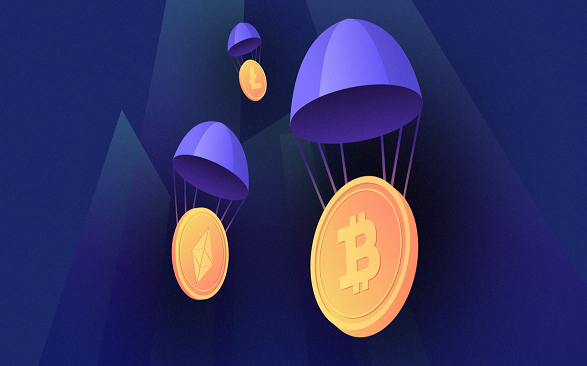Crypto airdrops have become a popular way for emerging crypto projects to announce their presence, compensate community members, as well as achieve widespread token circulation. It entails a project dispensing its native coin or tokens to selected users free of charge.
Crypto airdrops provide a chance for both newbies and experts to obtain cryptoassets without having to buy them. It might interest you to know that through this marketing strategy adopted by several companies, numerous airdrop hunters have made thousands and millions of dollars, thus increasing the overall interest in crypto airdrops.
Are you interested in crypto airdrops and knowing how to gainfully participate in them? Are you tired of being a spectator and missing out on massive airdrop campaigns? Then you are in the right place.
What do we mean by crypto airdrops?
The term ‘airdrop’ is used to define an event where users receive free cryptoassets from crypto project teams. You can also think of it as crypto giveaways.
In other words, crypto airdrops occur when a particular blockchain project gives out its native token or any other cryptoasset to selected users for free. This is often done to pay back community members for supporting a particular project, holding a specific cryptocurrency, or utilizing a certain blockchain platform.
The basic idea behind airdrops is to widely distribute newly minted crypto tokens to the public in hopes that users would be eager to engage with the project, bringing more traction and popularity to the blockchain project.
But to be eligible for any crypto airdrop, a user must meet certain requirements as outlined by a project team. Requirements for airdrop eligibility differ according to the nature and type of airdrop.
Notably, the Bitcoin (BTC) community executed the first crypto airdrop in 2010. At the time, every member of the Bitcointalk forum who posted at least one message before the specified date received 5 BTC. Since then, crypto airdrops have become a popular marketing approach for blockchain companies, with many employing them to onboard new users and reward existing ones.
In March 2014, the mysterious creator(s) of ‘Auroracoin’ distributed 50% of the coin’s total supply to the citizens of Iceland. The Uniswap and Arbitrum airdrops, which took place in 2020 and 2023 respectively, are also among the biggest airdrops where users reaped thousands of dollars in giveaways.
In what is called a retrospective airdrop, the popular decentralized exchange, Uniswap, gave out its native token — UNI — to users who utilized the DEX before 1 September 2020. This airdrop was worth around $1,200 at the time of issuance. Those who received the UNI airdrop watched its value skyrocket to more than $4,000 only a few months later.
With several other completed and planned airdrop campaigns in the ever-evolving crypto space where new projects are introduced every now and then, crypto airdrops have come to stay.
Types of crypto airdrops and How to Participate
There are various categories of crypto airdrops, each with different requirements and modes of participation. To get the best out of crypto airdrops, it is vital that you understand the types of crypto airdrops out there and how to participate.
1. Classic or Standard Airdrop
This is the most popular type of crypto airdrop where tokens are allocated to users who match specific requirements. This may range from holding a specific quantity of a specific token to executing a specific activity, such as publishing posts on social media platforms, joining project community groups, and others.
In most cases, users have to interact with a Telegram bot designed by the project. The bot assigns social media tasks, including liking and retweeting posts, following multiple accounts, or subscribing to YouTube channels. Qualified users get their tokens deposited into their wallet addresses after the airdrop event is over. The amount of tokens received by users depends on the number of tasks completed.
2. Bounty Airdrop
Here, users are paid for accomplishing certain high-profile tasks. These tasks may involve writing blog articles, making videos, producing software, or debugging protocol codes. Bounty airdrops are often employed to encourage users to assist with project marketing or development activities.
Some bounties require you to join a specific group and perform tasks. In other cases, you may need to create an account on Bitcointalk to get notified of bounty airdrops given that most blockchain projects publish their bounties on the platform.
3. Holder Airdrop
As the name implies, holder airdrop is an event where free tokens are handed out to users for holding a specific cryptocurrency in their wallet. These airdrops are often used to reward long-term investors or to urge individuals to keep HODLing a certain cryptoasset.
And yes, it’s quite easy to participate in this type of airdrop as all you need to do is hold a specific amount of specified tokens to qualify.
4. Fork Airdrop
A fork occurs when a new blockchain protocol births out of an existing blockchain. Accordingly, users holding the old tokens are usually issued the native token of the new project and this is known as a fork airdrop.
An example of this type of airdrop occurred in 2017 following the fork of the Bitcoin Cash network from the Bitcoin blockchain. Accordingly, BTC holders received BCH in an equivalent amount. The most recent fork airdrop was recorded in 2022 following the Merge upgrade that began Ethereum’s journey to becoming a proof-of-stake chain. The token ETHPOW was issued to wallets holding ETH at snapshot time.
Read also: The Ethereum Merge: What the crypto asset buyer should know
5. Retroactive Airdrop
Retroactive airdrop is a type of airdrop campaign where a crypto project (mostly DeFi platforms) distributes a portion of its native token’s supply to users who interacted with the said protocol in its early days.
To be eligible for most retrospective airdrops, one requirement is to be an early adopter of emerging DeFi platforms. More so, users have to complete several other conditions to get retroactive airdrop incentives. It could be offering liquidity, executing swaps, bridging tokens, and interacting with every element of the DeFi protocol.
In most cases, users are also required to interact with the testnet version of the developing project. Notably, while most projects do not announce their plans to embark on retroactive airdrops, some DeFi projects do in order to draw more attention to their projects.
As mentioned, Uniswap performed the first retroactive airdrop in 2020 when the team airdropped 400 UNI to every wallet that interacted with the protocol in its early days. Since then, many other projects including Paraswap, Arbitrum, and Optimism have toed this line.
Read also: Top 5 Decentralized Crypto Exchanges You Should Know
Risks in crypto airdrops
As you know, there are always two sides to every coin. While crypto airdrops bring many benefits to users, it also poses considerable risks.
One of such risks is that some airdrops could turn out to be a hoax. Given the high interest and participation in airdrop campaigns, many bad actors have taken advantage of the scheme to defraud participants by staging phoney airdrop events. It is, therefore, critical to do your own research DYOR and ensure that you participate in only authentic crypto airdrops.
How can you be defrauded through fake airdrops? Most airdrops, especially retroactive airdrops, require that you connect your wallet to a DeFi platform to carry out some activities such as token swapping, providing liquidity, and the like. When you do so, your wallet and all that’s contained therein become exposed. And you stand the chance of having your assets drained if the DeFi platform you connected your wallet to is a fraud.
There is also a possibility that some airdropped tokens you get may turn out to be worthless. This is true in a case where the particular crypto project offers no clear use cases.
Safety tips for crypto airdrops
Here are some pointers for newbies who want to successfully participate in crypto airdrops:
- Do Your Own Research: Before taking part in an airdrop, it’s critical to research the project and the team spearheading it. Examine the team members’ backgrounds and prior work. To get a better knowledge of the project’s aims and progress, consult its social media platforms, community forums, and whitepaper among others. And never rely 100% on “crypto experts”, “crypto gurus”, and the likes for recommendations.
- Have an Airdrop Wallet: Because there are many phoney crypto-airdrop campaigns out there, it is advisable to create a special wallet(s) for airdrops alone. And when you win an airdrop, it is wise to move out the funds to a more secure wallet.
- Follow Instructions: To guarantee that you are qualified for crypto airdrops, it is important to know all the requirements. Ensure that you obey all the rules to be eligible as thousands of users often take part in each airdrop event.
- Avoid Frauds: Legitimate airdrops will never ask for your private keys or need you to pay a certain amount to receive airdrops. Remember that they are called airdrops because they are free.
- Be Suspicious with Links from Nowhere: While crypto airdrops are giveaways, don’t give yourself away by being in too much hurry with clicking links. Suspicious links often drop on social media (Facebook, Instagram, and Twitter particularly), unsolicited emails, and even from instant-messaging platforms such as Telegram and WhatsApp. If it’s too good to be true, then it is most likely untrue.
Conclusion
Crypto airdrops have fast become one of the open secrets of getting amazing rewards in the crypto space. Active participants in crypto airdrops continue to contribute to the growth of the crypto ecosystem, particularly with the development-driven bounty airdrops and the community-focused classic or standard airdrops. The hodlers are also playing their parts, ensuring stability and sustainability of crypto projects through retroactive airdrops. But remember: If it’s too good to be true, it is most likely untrue. So ensure that you keep yourself safe from scammers. Follow our safety tips and reap bountifully from those crypto airdrops.
Read also: What is Tokenomics and Why Does It Matter to Crypto Investors?
Credit: Ndianabasi Tom A crypto journalist and content writer who has been talking about cryptocurrency and blockchain technology since 2018, Ndianabasi is a Writer at Crypto Asset Buyer (CAB).
Discover more from Crypto Asset Buyer
Subscribe to get the latest posts sent to your email.




